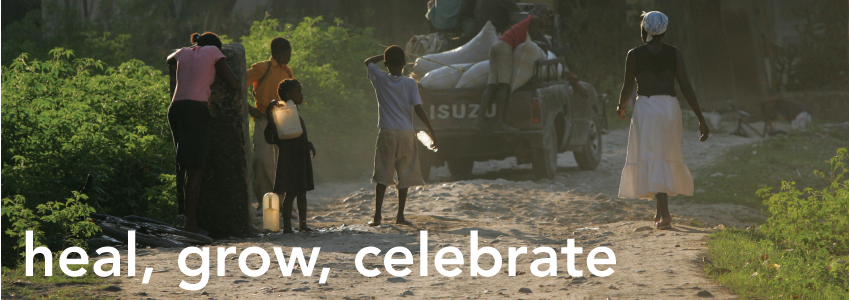Dear readers and contributors,
If you ask any number of people what December calls to their
minds, many will say the holidays and family time. Farmers in the Artibonite,
however, will say that it’s time to sow black turtle beans in the ground. For
us at HTRIP, December marks the end of one more year of accomplishments, which
of course includes measurable growth for the trees that we have planted in the mountains of the Artibonite region. Throughout this year, we have helped our sixty HTRIP communities in
diverse ways: by providing them with tools for their tree nurseries, building
cisterns to catch water, sponsoring different konbits (community work groups),
and organizing monthly training sessions about environmental care. Even though
we have had some changes in the management of the project and at Hôpital Albert
Schweitzer (HAS), our commitment to improve livelihoods of the people living in
the mountainous areas in the Artibonite stronger than ever.
 |
| HTRIP is looking forward for 2013 and a new year, while acknowledging our many achievements in 2012. |
Challenges such as drought, hurricanes, and flooding slowed down some of our activities through the year of 2012. For example,
tree distribution and plantation activities in some communities were delayed. Farmers
in many areas had to deal with the loss of crops and livestock suffered due to
hurricane damage. Still, we have managed to keep the project going by
completing all the monthly training sessions for our HTRIP community leaders
and participants. We have even worked to strengthen the capacity of our staff, introducing
seminars led by agronomist and Haitian native, Rony Horat, who joined the HTRIP
team in November. Last month we had a seminar about grafting and January’s
seminar focused on the cultivation of yams and other tubers that enjoy shady
areas.
 |
| Water catchment put up by HTRIP in Laborne. |
As we alluded to before in this letter, HTRIP has been
promoting the yam as a good shade-tolerant crop that has the ability to climb
trees to the top without harming the trees’ growth. By visiting older HTRIP
communities such as Source Dupon, Titon, and Goden where the trees are now
quite large and tall, it is possible to envision a symbiotic relationship
between the shade and height of the HTRIP trees and many shade-grown crops like
yam, taro and passion fruit. However, we are focusing on the yam because it is
already a popular crop in Haiti; yams can be consumed in many ways and it is a
big money-maker in local markets. We like yams so much, that we even have a
place in the Artibonite called Terre
Igname, which means “Yams’ Land” in English!
 |
| HTRIP's cabbage field experiment on the HAS Campus. |
We also have started with the idea of introducing HTRIP
gardens in the residences on the HAS campus. This effort will serve two
purposes: to experiment with shade-grown crops, and to beautify the HAS campus.
This month we have planted eighty-one seedlings of cabbage using Dr. Charbel
Bien Aime’s back yard. With this trial planting, we will be able to see how
well cabbage can be grown with limited sunlight.
Although this is just a sampling of some of our latest achievements, we are proud of all the activities that we have done during this
year, and very thankful of all the support that we have received from our
generous supporters and followers. It is with confidence and excitement that we
are welcoming 2013, as we have already set up our main goals for our nurseries.
Our staff, landowners, farmers, and community members are all driven by a
common objective of producing more than four-hundred thousand seedlings in 2013.
We greatly appreciate the generosity of our supporters and
the zeal of our readers for always helping us working towards our goals.
Sincerely,
The HTRIP Staff, including Melissa Sanon, Starry Sprenkle, and Rony Horat
